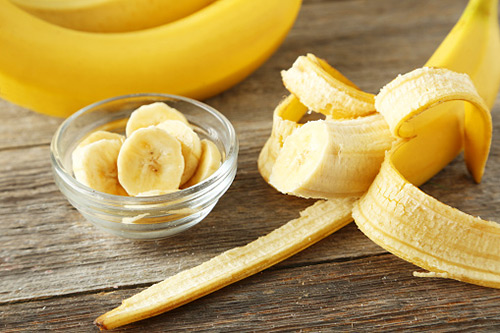 Can bananas and diabetes go hand-in-hand? It goes without saying that diabetics need to be careful about their blood glucose levels. A careful ‘goldilocks’ level needs to be struck—not too high and not too low. The problem is that some foods can unexpectedly skew a diabetic’s blood sugar and cause adverse effects.
Can bananas and diabetes go hand-in-hand? It goes without saying that diabetics need to be careful about their blood glucose levels. A careful ‘goldilocks’ level needs to be struck—not too high and not too low. The problem is that some foods can unexpectedly skew a diabetic’s blood sugar and cause adverse effects.
Take the common banana, for instance. Although diabetics can have fruit, as long as they are aware of the glucose level, bananas have a noticeably higher glucose and carb content. Eating a banana and expecting an effect similar to an apple can result in an unwanted spike in blood sugar and, in the worst case, trigger a hyperglycemic episode. It is for this reason that some diabetic diets discourage eating bananas, but the truth is that they can be eaten safely. It just takes a bit of prudence.
What’s the Big Deal About Bananas?
Glycemic index of bananas: To understand why bananas would be a special concern to diabetics, it helps to look at the Glycemic Index. This is an impressive database that aims to quantify the relative impact that carbohydrates will have on your blood glucose level. Every food in the index contains a glycemic index rating, which assesses how high and for how long the food will raise your blood sugar, and a glycemic load rating, which is a combined value that consists of the combined quality and quantity ratings of the carbohydrates. The formula used to calculate all this is a very dense read to explain, but the main idea is that the lower glycemic load or index number, the less significant or prolonged impact the food has on your blood sugar as your body turns the carbohydrates into glucose.
Bananas and carb concern:The reason the glycemic index and load numbers are useful is because the number of carbs per serving are not a full picture. Two foods with the same number of carbs will still be handled by your body differently due to their individual properties and other components such as the presence of fat (or lack thereof). The glycemic index and load values are determined by taking this behavior into account.
Comparing bananas to other popular fruits: To begin, compare the glycemic index values for a serving of raw pear (up to 42), an orange (up to 48), and an apple (up to 44). Next, look at bananas. A serving of one ripe banana has a glycemic index value of up to 51 and a serving of a raw banana can have a glycemic load as high as 62.
The takeaway here is that bananas can spike your blood glucose levels much stronger and faster than many other kinds of fruit. The most direct way to address this is to stop eating bananas and not bother with this problem. Of course, since bananas are delicious, a better method exists…
The Diabetic Banana
The ideal banana for a diabetic to eat is the “extra-small” variety. These are no more than six inches long and contain about 19 grams of carbohydrates per serving, as opposed to the 25 grams of carbs in a regular banana.
A banana’s ripeness also affects its glycemic index. This is because the carb content of a banana is mostly locked up in starches. As the banana ripens, some of the starch will convert into free sugars that have a more immediate impact on your blood glucose levels. An unripe or under-ripe banana can have a glycemic index anywhere from 30 to 48, depending on the stage.
If you want to try something other than chopped slices, you may be surprised to know that a slice of banana cake actually has a glycemic index value of 47, less than the raw fruit. This is because banana cake is a “slow releasing carbohydrate” perfect for diabetics. Your body processes it at a slower pace, meaning it can be a nice treat that won’t spike your blood sugar. The same applies to banana milkshakes and smoothies made with full-fat or soy banana-flavored milk.
Plantains are also a good alternative. Although they need to be cooked first, plantains have fewer carbs and sugars in them than bananas and can be an acceptable alternative to some tastes.
Bananas: Delicious, Nutritious and Healthy
This sort of analysis may seem like overkill for a single fruit, but bananas can be well worth it in the end. Besides being good for diabetes, bananas have other benefits too. Bananas are great sources of fiber, vitamin B6, vitamin C, potassium, and are low in calories overall. This blend of nutrients can improve mood and immune function and even ease blood pressure. Potassium in particular is of special interest, since bananas are one of the best sources of this nutrient and many Americans simply don’t get enough.
A good point to keep in mind is that while bananas may be higher on the Glycemic Index than other fruits, they are still within the range of what are considered low-glycemic foods; a slice of bread has a higher glycemic index than a banana, after all. As long as you keep track of your blood sugar and understand the impact a banana can have on your body diabetes, there’s no reason you can’t enjoy one of the country’s most popular fruits.
Sources for Today’s Article:
Bruso, J., “Can a Diabetic Eat Bananas,” Healthy Eating web site, http://healthyeating.sfgate.com/can-diabetic-eat-bananas-2717.html, last accessed November 4, 2015.
Carson, C., “Bananas and Diabetes,” BattleDiabetes web site, April 27, 2011; http://www.battlediabetes.com/articles/diet/bananas-and-diabetes, last accessed November 4, 2015.
Ford, K., “The Glycemic Index of Bananas,” Livestrong.com, January 28, 2015; http://www.livestrong.com/article/254976-the-glycemic-index-of-bananas/.
“Glycemic Index,” Glycemic Index web site, http://www.glycemicindex.com/index.php, last accessed November 4, 2015.
